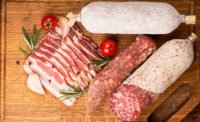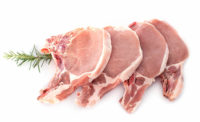Where you stand is largely determined by where you sit.
Ask a pig farmer about their outlook on the pork industry, and they’ll likely talk about feed prices, federal, state and local regulations, the trade environment and the cutout value.
State of the Industry 2019
OverviewBeef (NCBA)
Pork
Chicken
Food Safety
Packaging
Beef (CAB)
Turkey
Veal
Lamb
Animal Welfare
Seafood
Workforce
Watch the 2019 State of the Industry Webinar
Register for free today!
An economist will talk about the same issues, but with slides and charts and show data about consumer per-capita expenditure and consumption.
Both will talk about African swine fever and the opportunities it poses internationally and the threats it poses domestically.
Someone in marketing will talk about the latest trends that are moving through the menu adoption cycle, the flavors gaining traction in the meat case or the innovative appliance that’s going to simplify life in professional and at-home kitchens.
“These are valuable perspectives and conversations our industry needs to have, because they give us direction in a real-time, short-term basis,” says Jarrod Sutton, vice president of Domestic Marketing for the National Pork Board. “But having a longer-term strategy is equally important. We have to be thinking five, 10, 20 years down the road to make sure pork is positioned for success in the future.”
That long-term success will be grounded in a deeper understanding of the consumer, their needs, and how to meet them.
ANNUAL PORK FORECASTS
| 2016 | 2017 | 2018 | 2019 | 2020 | |
| Production (million lb.) | 24,941 | 25,584 | 26,315 | 27,633 | 28,410 |
| Per capita disappearance (retail lb.)* |
50.1 | 50.2 | 50.9 | 52.1 | 52.3 |
| Pork exports (million lb.) |
5,239 | 5,632 | 5,876 | 6,455 | 6,945 |
| Pork imports (million lb.) |
1,091 | 1,116 | 1,042 | 956 | 915 |
Forecasts are in bold. * Per capita meat disappearance data are calculated using the Resident Population Plus Armed Forces Overseas series from the Census Bureau of the Department of Commerce. All data as of Aug. 15, 2019. Source: World Agricultural Supply and Demand Estimates and Supporting Materials. For further information, contact: Mildred M. Haley, mhaley@ers.usda.gov
Understanding consumer attitudes, behaviors
“People live, shop and eat differently today. The pork industry has tremendous momentum with consumers, and that can be leveraged further through innovation in product development, bringing contemporary eating solutions to consumers,” Sutton says. “It’s vital that we intimately understand the needs and constraints that influence consumer dining choices and provide a clear path for product innovation that is rooted in data.”
At the center of this effort is the most extensive gathering of consumer insights the Pork Board has undertaken. Of particular interest: the Millennial and Latino consumer segments.
According to the U.S. Census Bureau, Millennials — those born from 1982 to 2000 — total 83.1 million people, or 25 percent of the U.S. population, and outnumber Baby Boomers.
Meanwhile, almost one in five people in the United States, or 55 million, is Hispanic, the largest ethnic minority. Latinos in America will represent more than $1.7 trillion in buying power in 2020 — and that buying power is growing at twice the rate of non-Hispanics.
With the goal of building a deeper understanding of consumer attitudes and behaviors, the Pork Board has spent the last two years collecting a wealth of data it is sharing with the industry through three major research reports released in 2019. The foundation of these reports is a three-part survey conducted with more than 10,000 participants.
These insights can help identify trends and opportunities for packers, processors, retailers and food service companies alike. With the large sample size, the Pork Board has been able to dive deeply into key consumer segments, looking not only at age and ethnicity, but geographically as well.
At-home needs
When looking at consumer needs for at-home dining, the research in January’s Dinner at Home in America report uncovered nine unique dining occasions, or needs states, happening in homes on any given night of the week, ranging from solo dining to celebrating with extended family. During the course of any week, the same person can experience multiple eating occasions as their needs throughout the week change.
These nine occasions also clearly identify opportunities for the industry to respond to changing consumer behaviors and drive category growth in three areas:
- Health: Consumers need more education about the known health benefits, nutrient density and protein content of fresh and packaged pork cuts.
- Simplicity and ease: The consumer wants convenience and portions that match their needs. There’s opportunity to continue to innovate in both packaging and cuts, and to offer more precooked or pre-seasoned options. Today’s consumer needs on pack cooking and temperature directions.
- Versatility: Consumers aren’t thinking of “protein as center-of-the-plate” any more. They want meal solutions with protein as a key ingredient. Consumers seek diversity in their protein choice — from tacos to sandwiches and pasta to casseroles.
REFRIGERATED BREAKFAST/ HAM: TOP 10 RETAIL BRANDS
| Brand | Dollar Sales | Dollar Sales % Chg YAgo | Unit Sales | Unit Sales % Chg YAgo |
| Jimmy Dean | $560,013,869 | 5.6% | 141,306,767 | 4.5% |
| Johnsonville | $206,079,656 | -2.7% | 62,211,552 | 0.7% |
| Private Label | $205,755,376 | 8.4% | 77,581,824 | 7.8% |
| Bob Evans | $140,363,348 | -4.0% | 37,807,226 | -8.0% |
| Odom's Tennessee Pride |
$107,721,279 | -9.9% | 29,001,597 | -10.1% |
| Swaggerty | $61,955,311 | 3.2% | 12,434,262 | 4.7% |
| Farmer John | $35,110,324 | 10.9% | 23,701,040 | 14.8% |
| Hatfield | $30,693,636 | 3.0% | 11,655,333 | 5.5% |
| Owens | $29,737,957 | -1.7% | 8,109,379 | -4.1% |
| Jennie-O | $29,247,464 | -5.2% | 8,889,701 | -8.4% |
| Total Refrigerated Breakfast Sausage/ Ham |
$1,790,803,622 | 1.5% | 531,208,777 | 1.2% |
REFRIGERATED BACON: TOP 10 RETAIL BRANDS
| Brand | Dollar Sales | Dollar Sales % Chg YAgo | Unit Sales | Unit Sales % Chg YAgo |
| Private Label | $1,203,099,792 | 6.4% | 261,889,460 | 7.3% |
| Oscar Mayer | $911,225,770 | 4.3% | 168,414,186 | 4.4% |
| Hormel Black Label |
$532,305,682 | -0.3% | 87,321,139 | -1.1% |
| Wright | $420,861,445 | 7.1% | 40,765,736 | 10.9% |
| Smithfield | $377,151,854 | -1.4% | 77,939,636 | 0.1% |
| Farmland | $171,075,489 | -2.9% | 35,450,335 | -0.6% |
| Bar-S | $85,953,409 | 7.8% | 23,987,801 | 12.3% |
| Jimmy Dean | $84,819,803 | 50.7% | 23,615,305 | 70.5% |
| Farmer John | $71,872,515 | 2.0% | 14,858,154 | 4.5% |
| Sugardale | $60,459,423 | -21.2% | 14,929,191 | -16.1% |
| Total Refrigerated Bacon |
$4,895,087,013 | 2.0% | 973,780,971 | 2.4% |
| Total Breakfast Meats |
$6,685,890,635 | 1.8% | 1,504,989,748 | 2.0% |
Source: IRI, a Chicago-based market research firm (@iriworldwide). Total US Multi-Outlet w/ C-Store (Grocery, Drug, Mass Market, Convenience, Military and Select Club & Dollar Retailers), latest 52 weeks ending Aug. 11, 2019.
Note: Rankings of top brands are NOT totaled brand listings (e.g. all UPCs or brand extensions rolled up into a single figure, such as Total Crest Toothpaste), but are rather individual brand listings.
Dining out
“Pork is the No. 1 consumed protein globally, yet fresh pork is the featured protein in less than 7 percent of entrée options when dining out in the U.S. That seems contradictory,” Sutton says. “With the growing popularity of Asian and Latin cuisines, where pork is a staple and a centerpiece, foodservice operators at every point on the spectrum have the opportunity to provide their customers with more flavorful and authentic options.”
Insights from the All About Dining Out: What’s On Trend report, released May 2019, confirm three primary drivers for consumer decisions when considering where and what to eat when dining out: taste, health and convenience.
From a taste perspective, diners seek menu options they don’t usually make at home. One in four consumers (27 percent) consistently look for something new to eat and they see dining out as an opportunity to treat themselves and indulge a little bit. The previous Dinner at Home report revealed consumers don’t keep pork on hand at home as often as other proteins, so with it not being eaten at home as often, it easily becomes that treat/indulgence they are looking for.
Pork is a staple in Latin and Asian dishes, so providing that authentic experience consumers demand is easy for foodservice operators who put pork on the menu. When asked which pork dishes people crave, 51 percent say they crave Mexican and Latin pork dishes and 45 percent say they crave Asian pork dishes.
While health isn’t the main reason people dine away from home, it’s still important to consumers that menus have healthy options. Restaurants can expand the menu to include lean fresh pork options such as the pork tenderloin or the pork sirloin chop in the same set as other proteins, such as chicken or seafood.
When health is the primary driver for a consumers’ dining-out decision, roughly six in 10 diners want a food that is “reasonably healthy,” and roughly four in 10 want a food that fits their diet.
Make it easy, make it fast. Convenience was the primary need for consumers in 38 percent of away-from-home dining occasions. Consumers have high expectations for convenience when out to eat, and technology and the proliferation of on-the-go dining options have.
REFRIGERATED DINNER SAUSAGE: TOP 10 RETAIL BRANDS
| Brand | Dollar Sales | Dollar Sales % Chg YAgo | Unit Sales | Unit Sales % Chg YAgo |
| Johnsonville | $711,152,789 | 1.3% | 182,484,702 | 2.5% |
| Hillshire Farm | $476,709,087 | 7.2% | 146,076,181 | 7.6% |
| Private Label | $404,377,803 | 2.9% | 105,729,491 | 2.9% |
| Eckrich | $279,217,827 | 4.3% | 87,572,747 | 4.4% |
| Hillshire Farm Lit'l Smokies |
$139,946,303 | 5.4% | 41,482,309 | 6.0% |
| Aidell's | $98,251,863 | 0.5% | 17,528,339 | 1.1% |
| Premio | $92,789,374 | -1.6% | 19,487,804 | -4.1% |
| Bar-S | $58,379,061 | -0.5% | 12,215,778 | -2.9% |
| Conecuh | $54,216,652 | 0.0% | 10,610,981 | -3.2% |
| Cacique | $39,949,756 | 13.2% | 31,085,699 | 13.9% |
| Total Refrigerated Dinner Sausage |
$3,593,972,600 | 2.1% | 956,031,172 | 2.2% |
REFRIGERATED FRANKFURTERS: TOP 10 RETAIL BRANDS
| Brand | Dollar Sales | Dollar Sales % Chg YAgo | Unit Sales | Unit Sales % Chg YAgo |
| Ball Park | $529,407,987 | -0.5% | 142,985,726 | 0.6% |
| Oscar Mayer | $369,914,324 | 5.2% | 125,525,425 | 7.2% |
| Bar-S | $287,850,759 | -1.6% | 218,953,978 | -5.1% |
| John Morrell Nathan's Famous |
$250,317,676 | 6.9% | 53,884,630 | 5.0% |
| Hebrew National |
$165,573,614 | -4.9% | 35,783,632 | 1.0% |
| Private Label | $71,516,867 | 19.3% | 24,490,437 | 3.7% |
| Bar-S | $85,953,409 | 7.8% | 23,987,801 | 12.3% |
| Oscar Mayer Selects |
$45,089,739 | -18.1% | 11,075,167 | -28.8% |
| Sabrett | $37,566,544 | 6.5% | 7,271,243 | 8.3% |
| Gwaltney | $34,444,226 | 2.2% | 23,562,820 | 2.2% |
| Eckrich | $23,418,967 | -4.7% | 14,471,610 | -2.4% |
| Total Refrigerated Frankfurters |
$2,368,531,510 | 0.0% | 831,301,538 | -2.0% |
Source: IRI, a Chicago-based market research firm (@iriworldwide). Total US Multi-Outlet w/ C-Store (Grocery, Drug, Mass Market, Convenience, Military and Select Club & Dollar Retailers), latest 52 weeks ending Aug. 11, 2019.
Note: Rankings of top brands are NOT totaled brand listings (e.g. all UPCs or brand extensions rolled up into a single figure, such as Total Crest Toothpaste), but are rather individual brand listings.
Latinos are pork’s future
From the head to the tail and every cut in between, pork is entrenched in Hispanic heritage and culture. Whether celebrating milestone moments, large gatherings of family and friends or everyday meals, pork is at the table. It plays a significant role in establishing a sense of community and family.
Given Latinos’ aforementioned buying power, this is theoretically great news for the domestic U.S. pork industry. We have consumers who love our product.
But as October 2019’s report Time to Tango: Latinos Are Pork’s Future reveals, there are signs of concern.
As Hispanics become acculturated in the U.S., our data shows the strong link between pork and culture weakens. Nearly half (49 percent) of Hispanics do not choose mainstream retailers as their go-to store, and instead opt for specialty stores, ethnic markets and bodegas. The traditional retail meat case may be a core contributing factor — 44 percent of Hispanics choose to buy their fresh meat at non-mainstream grocery stores. If they can’t find the pork cuts their traditional dishes call for, they migrate to other proteins or seek specialty shops.
As with many of their non-Hispanic counterparts, U.S. Latinos have misconceptions about pork’s nutrition. If we don’t reinforce the Hispanic connection to pork and dispel some of the inaccuracies about the “healthfulness” of pork, we may lose a once-in-a-generation opportunity.
Hispanics have a strong desire to stay connected to their culture, traditions and family, and if we make the necessary changes today, the connection with pork can remain central and vital at every stage of acculturation.
But that means thinking differently, both at the processing plant and at retail. In this report, we’ll explore three key areas where stakeholders can win with Latinos: accessibility, health and authenticity.
Marketing pork to Latinos is not a one-size-fits-all solution. To successfully communicate and engage Hispanics, we must pay attention to both the similarities and differences between different Hispanic groups. What works well in Florida may not be successful in California. And an entirely different approach may be necessary in the Northeast. Latinos are a mosaic of cultures, and understanding their needs and connecting with them is a highly nuanced — but vital — proposition for our long-term success. NP




Report Abusive Comment